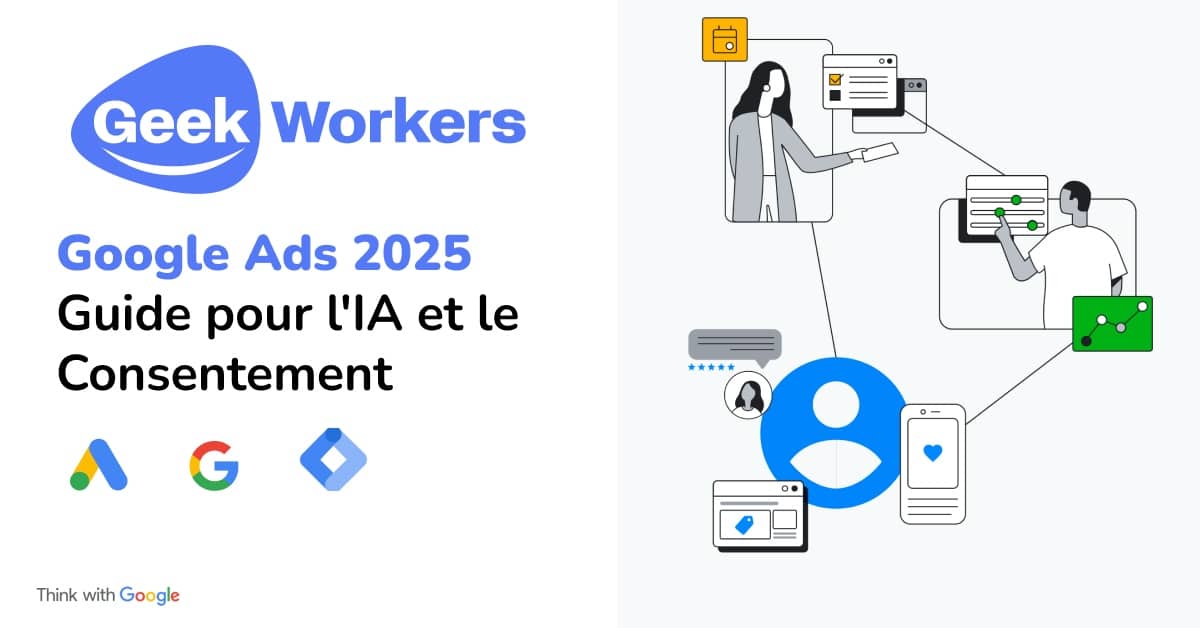
The online advertising landscape is constantly evolving, and Google Ads is no exception. Web and marketing agencies must adapt to the new rules of the game to ensure the performance of their clients' campaigns. Between the gradual disappearance of third-party cookies, the rise of artificial intelligence (AI) and the obligation to respect user consent (Consent Mode v2), it is crucial to master the new strategies.
At Geekworkers, an agency specializing in web development and digital marketing, we are closely following these developments. With our experience and expertise, we have deciphered for you the key trends of Google Ads for 2025. This complete guide based on official Google recommendations will provide you with the knowledge and concrete actions to implement to ensure the success of your campaigns and those of your clients. We will address the technical, strategic and regulatory aspects, in order to offer you a 360-degree vision.
Artificial intelligence is no longer an option, but a core element of any successful Google Ads strategy. It allows you to automate and optimize campaigns much more effectively than a human could.x
Smart Bidding (or smart bidding strategies in French), these are automatic bidding strategies that use Google's artificial intelligence to optimize your campaigns.
Instead of manually setting the cost per click (CPC) for each keyword, you let Google adjust your bids in real time, with each auction (“time-of-auction bidding”).
The goal? " Maximize conversions (or conversion value) depending on your goals"
Google Ads offers several Smart Bidding strategies, each tailored to a specific goal:
Now that you understand how AI can manage your auctions with Smart Bidding, let’s go further. Let’s see how AI can support the whole thing of your campaign, from ad creation to ad delivery, including targeting and budget optimization with Performence Max (the most important!) and Responsive Search Ads (RSA).
Performance Max is the future of marketing according to Google. It is not just an additional option, but an approach global which uses artificial intelligence to automate and optimize all aspects of your campaign.
Max Performance automates nearly every aspect of your campaigns: budget, bidding, ad creation, and targeting. You set your goals, and AI continuously optimizes to achieve them.
With Performance Max, you don't manually choose keywords, placements, or ad types. Instead, you provide Google with the ingredients basic:
Once these elements are provided, Google's AI takes over:
In summary, Performance Max is a powerful solution for advertisers who want to simplify the management of their Google Ads campaigns and maximize their performance through AI. However, it is important to understand how it works and follow best practices to get the most out of it.
With Responsive Ads (RSA), you don't create a single, fixed ad. You provide Google with several elements:
Google AI then tests automatically different combinations of titles and descriptions, and delivers the combinations that perform best with your target audience.
Advantages of RSA:
Best Practices for RSA:
In short, RSAs are a powerful tool to improve the relevance and performance of your search ads. By combining your deep semantic analysis with the power of Google’s AI, you can create ads that capture your audience’s attention and drive results.
In a world where third-party cookies are fading away, first-party data (the information you collect directly from your customers, with their explicit consent) becomes your most valuable asset. This chapter explains how to collect this data, respect consent (via Consent Mode v2) and, crucial point, how to accurately measure the performance of your campaigns, even with limited data. Google uses the modeling to estimate conversions that are not directly observable, and it is essential to connect your conversion data offline (in-store sales, phone calls, etc.) for a complete view.
Collect first-party data is not just about accumulating information. It’s about building a relationship of trust with your customers, based on transparency and added value in exchange for their data.
Here are the key elements:
Geekworkers offers complete installation, configuration and training services on GA4 and GTM.
THE Consent Mode v2 is a standard and mechanism proposed by Google OBLIGATORY for all advertisers targeting users in the European Economic Area (EEA) and the United Kingdom. It allows your website to communicate to Google the consent status of each visitor (has he accepted or refused advertising and/or analytical cookies?).
Google tags (the little bits of code that are used for tracking) adapt their behavior based on this status.
Request for Consent
Before collecting the slightest data, you must ask the user whether he accepts (or refuses) that you use his information for advertising and/or analytical purposes (via a cookie banner, for example).
Communication to Google
Consent Mode v2 allows your site to communicate this choice of consent to Google.
Adaptation of Tags
Google tags (Google Ads, GA4, etc.) adapt to the consent status:

Geekworkers is an expert in implementing Consent Mode v2. Contact us for personalized assistance. See article Consent Mode v2
Adaptation is the key to success on Google Ads in 2025. By mastering AI, ethically leveraging first-party data, respecting user consent by implementing Consent Mode V2, and targeting intent, you can help your clients achieve their goals. Geekworkers, with its expertise in digital marketing and web development, is the ideal partner to support you in this transition.
Do you want to optimize your Google Ads campaigns and those of your clients?
Contact Geekworkers today for a free consultation and personalized quote!
Our web agency is focused on quality and satisfaction for both
entrepreneurs, SMEs and large companies in French-speaking Switzerland
Our Web & Marketing agency is present at Lausanne since 2020 and now has more than 25 employees to support SMEs, entrepreneurs and large companies in French-speaking Switzerland.
More infos

Marketing Manager

Technical Manager
Your local digital partner. Creation of high-impact WordPress sitesstrategies effective marketing and support reagent.
Create a exceptional shopping experience. We develop WooCommerce shops optimized conversion and SEO.
Generate more leads and sales. Strategies SEO, SEA (Google Partner) and Social Ads tailor-made for maximum impact.
Geekworkers is a web agency based in Lausanne, French-speaking Switzerland, specializing in the creation of websites, e-commerce stores, mobile applications, and digital marketing (SEO, Google Ads, and Social Media) to help you succeed online. We have helped more than 300 businesses and entrepreneurs in Switzerland achieve success with their online projects.
Our affordable pricing has been designed for entrepreneurs, start-ups and SMEs as well as large companies with high standards of service.
To provide the best experiences, we use technologies such as cookies to store and/or access device information. Consenting to these technologies will allow us to process data such as browsing behavior or unique identifiers on this site. Not consenting or withdrawing consent may adversely affect certain functionality and features.